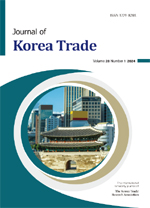
Trade-Embedded GHG Emission Transfer between South Korea and the EU
Trade-Embedded GHG Emission Transfer between South Korea and the EU
- 한국무역학회
- Journal of Korea Trade (JKT)
- Vol.28 No.1
- : SSCI
- 2024.02
- 165 - 190 (26 pages)
Purpose - The purpose of this study is to examine the implications of the Carbon Border Adjustment Mechanism (CBAM) for the transfer of greenhouse gas emissions (GHGs) through bilateral trade between Korea and the EU. Therefore, this study points out CBAM’s observable adverse effects from a consumption-based accounting perspective and suggests the proportion of the CBAM levy that should be refunded to Korea’s carbon reduction technology development fund as a way to address this. Design/Methodology – This study uses a multi-regional input-output (MRIO) model to analyze the extent to which industry-specific GHGs are transferred to each other due to bilateral trade between Korea and the EU. Then, using the emissions embodied in the bilateral trade (EEBT) model, we calculate the CBAM levy in Korea and the amount of funds that should be returned to carbon reduction technology development as an example. Findings – Our results show that Korea is a net exporter of GHGs to the EU’s final demand, and that the EU’s consumption-based GHGs are about twice as large as Korea’s when calculating each other’s consumption-based GHGs based on the industries covered by CBAM. In addition, we calculate the intensity-based shared responsibility of Korea and the EU for emissions exported from Korea to the EU to calculate the proportion of the CBAM levy that Korea should refund, and show an example. Originality/value – This study, unlike the existing literature on consumption-based emissions, calculates the transfer of GHGs from bilateral trade between Korea and the EU from the perspective of consumption-based accounting and provides implications for CBAM. It also argues that using the EU’s CBAM revenues to develop carbon reduction technologies in countries exporting to the EU could be more effective in reducing GHGs. Additionally, it emphasizes the need for the international monitoring of the EU’s CBAM revenues to ensure fairness and transparency.
1. Introduction
2. Literature Review
3. Data and Methodology
4. Results
5. Discussion and Conclusion
References